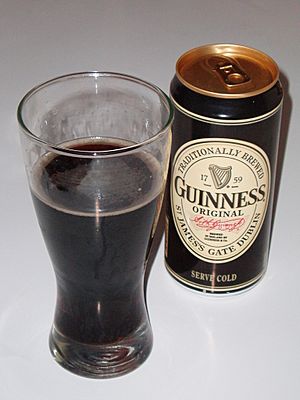Guinness facts for kids
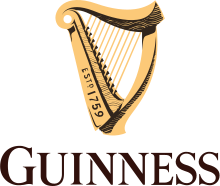 |
|
| Type | Stout (beer) |
|---|---|
| Manufacturer | Diageo |
| Country of origin | Ireland |
| Introduced | 1759 |
| Alcohol by volume | 4.2% |
| Colour | Black (sometimes described as very dark ruby-red) |
| Flavour | Dry |
Guinness is a famous dark beer called a stout. It started in Dublin, Ireland, at the St. James's Gate in 1759. A man named Arthur Guinness began brewing it. Today, a big company called Diageo owns Guinness.
Guinness is one of the most popular alcohol brands around the world. It is made in nearly 50 countries and sold in over 120! In 2011, people bought 850 million litres of Guinness. Even though sales have changed, it is still the top-selling alcoholic drink in Ireland.
You can visit the Guinness Storehouse in Dublin. It is a popular place for tourists. Since it opened in 2000, over 20 million people have visited!
The special taste of Guinness comes from malted barley and roasted barley. The thick, creamy top (called a head) on the beer comes from mixing it with nitrogen and carbon dioxide gas.
Contents
Guinness History
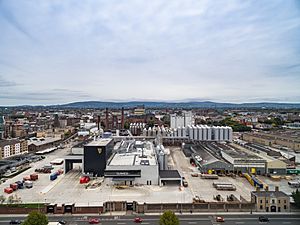
Arthur Guinness started making beer in 1759. He signed a very long lease for his brewery in Dublin. It was for 9,000 years! Ten years later, in 1769, Arthur Guinness sent his beer to Great Britain for the first time.
In 1778, Arthur Guinness began selling a dark beer called "porter." Later, in the 1840s, Guinness started using the word "stout." At first, "stout" meant a strong beer. But over time, it started to describe the beer's color and thickness.
Guinness became one of the biggest brewers in Britain and Ireland. Their sales grew a lot. In 1886, Guinness became a public company. This meant people could buy shares in the company. Even without advertising much, Guinness was very successful.
The brewery was also a leader in checking the quality of its beer. They even hired a statistician, William Sealy Gosset, in 1899. He developed important ways to test things for Guinness.
By 1900, Guinness had great programs for its 5,000 employees. They spent a lot of money to help their workers. By 1914, Guinness was making a huge amount of beer. It was more than double what its closest competitor made.
When World War I started in 1914, Guinness encouraged its employees to join the British forces. Over 800 employees served in the war. Guinness helped their families by paying half wages. They also promised jobs when the soldiers returned. Sadly, 103 employees did not come back from the war.
During World War II, people in the UK really wanted Guinness. This helped the UK lift some trade rules with Ireland.
In the 1970s, Guinness changed its Extra Stout to make it easier to drink. They made it a bit lighter. In 2014, they brought back two new porter beers.
In 1997, Guinness joined with another company to form Diageo. Guinness still kept its own brand and trademarks.
The Guinness brewery in London closed in 2005. Now, all Guinness sold in the UK and Ireland is made at the St. James's Gate Brewery in Dublin.
Guinness used to have its own ships and barges. In 2007, there was talk about closing the historic Dublin plant. But on May 9, 2008, Diageo announced that the St. James's Gate brewery would stay open. It would get new updates. However, other breweries in Kilkenny and Dundalk would close.
In 2017, Guinness made their beer suitable for vegetarians and vegans. They changed how they filter the beer. They stopped using a product from fish bladders.
What's in Guinness?
Guinness stout is made from water, barley, roasted malt extract, hops, and brewer's yeast. Some of the barley is roasted. This gives Guinness its dark color and special taste. The beer is also pasteurised and filtered.
Before the 1960s, Guinness was put into wooden barrels. Then, they started using aluminum kegs instead. These were sometimes called "iron lungs."
Until 2016, Guinness used a product from fish to help settle particles in the beer. This made it not suitable for vegans. But in 2018, Diageo announced they would stop using it. Now, draught Guinness is fine for vegans and vegetarians.
Guinness Today
In 1959, Guinness made a big change. They started using nitrogen gas. This made the beer's texture and taste different. Nitrogen bubbles are much smaller than carbon dioxide bubbles. This gives Guinness a "creamier" and "smoother" feel.
Nitrogen does not dissolve as easily as carbon dioxide. This lets the beer be under high pressure without getting too fizzy. The high pressure helps create very tiny bubbles. These bubbles make the special "surge" effect when you pour the beer. Cans and bottles have a small plastic ball called a "widget" that does the same thing. The smooth feeling of Guinness comes from its low carbon dioxide and the creamy head.
Even though Guinness looks black, it is also described as a very dark shade of ruby red.
Guinness and Health Claims
In the 1920s, Guinness had an advertisement that said, "Guinness is Good for You." This came from people saying they felt good after drinking it. Today, rules in Ireland do not allow alcohol ads to say drinks improve your health. Diageo, the company that makes Guinness, says they never make medical claims for their drinks.
A study in 2003 suggested that stouts like Guinness might help reduce bad cholesterol. This was thought to be because stouts have more antioxidants than lighter beers. However, the health benefits of antioxidants are still being studied.
Guinness Types
Guinness stout comes in different types and strengths:
- Guinness Draught: This is the most common type. It is sold in kegs, cans, and bottles. It has about 4.1% to 4.3% alcohol. There is also an "Extra Cold" version served very chilled.
- Guinness Foreign Extra Stout: This is a stronger version, around 7.5% alcohol. It is sold in many parts of the world like Europe, Africa, and Asia. Its strength can change depending on where it is sold.
- Guinness Special Export Stout: This type was first made for Belgium in 1912. It has 8% alcohol.
- Guinness Extra Smooth: This is a smoother stout sold in some African countries. It has 5.5% alcohol.
- Malta Guinness: This is a sweet drink that does not have alcohol. It is made in Nigeria.
- Guinness Zero ABV: This is a non-alcoholic drink sold in Indonesia.
- Guinness Mid-Strength: This is a lower-alcohol stout, with 2.8% alcohol. It was tested in Ireland.
- Guinness Red: This is a red ale with a lighter, fruitier taste. It has 4% alcohol.
- 250 Anniversary Stout: This was released in 2009 to celebrate 250 years of Guinness. It has 5% alcohol.
- Guinness West Indies: This is a porter beer that tastes like toffee and chocolate. It has 6% alcohol.
From 2005 to 2007, Guinness had a "Brewhouse Series." These were special, limited-edition stouts.
In 2010, Guinness started testing Guinness Black Lager. In 2014, they released Guinness Blonde, a lager made in the US. In 2015, they released another lager called Hop House 13.
In 2020, Guinness introduced Guinness 0.0, a zero-alcohol canned stout. It was taken off sale for a short time but relaunched in 2021.
In 2021, Guinness Nitrosurge cans were released. These cans do not have a widget. Instead, a special device on top of the can activates the nitrogen as you pour.
How to Pour and Serve Guinness
Guinness recommends a "double pour" when serving. This means pouring the beer in two steps. The company says this should take two minutes. Guinness has even used the slogan, "good things come to those who wait."
The brewer suggests that regular Guinness should be served at 6-7°C (42.8°F). Extra Cold Guinness should be served even colder, at 3.5°C (38.6°F).
To pour a pint, hold the glass at a 45° angle. Fill it three-quarters full. The beer goes through a special plate in the tap. This creates tiny nitrogen bubbles that form the creamy head. After the first pour settles, fill the rest of the glass. The head should form a small dome over the top.
In 2010, Guinness changed their pint glass design. The new glass is taller and narrower. Guinness suggests taking gulps from the glass instead of sips. This helps avoid the bitter taste of the nitrogen foam.
Sinking Bubbles in Guinness
When you pour Guinness, the bubbles seem to go down in the glass. This happens because bubbles near the glass walls move slower. Bubbles in the middle rise faster. As beer rises in the center, the beer near the sides of the glass falls. This downward flow pushes the bubbles near the glass towards the bottom. This effect is very clear in dark nitrogen stouts like Guinness.
A study in 2012 found that the shape of the glass also plays a role. If the glass gets wider as it goes up, bubbles will sink along the walls. This is true for the standard Guinness pint glass.
Guinness Advertising
The Guinness harp symbol is based on the Trinity College harp. Guinness started using it in 1862. Harps have been a symbol of Ireland for a long time. Guinness registered their harp as a trademark in 1875. It faces right, which helps tell it apart from the official Irish coat of arms.
Since the 1930s, Guinness has had many marketing campaigns. Before then, they did not advertise much. People just talked about the beer.

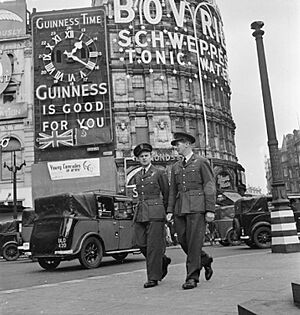
Famous advertisements were created by S. H. Benson's advertising agency. Artist John Gilroy drew many of them. These ads used phrases like "Guinness for Strength" and "Guinness Is Good for You." The posters often showed animals like a kangaroo, seal, or a toucan. The toucan became a well-known symbol for Guinness.
In the late 1980s, actor Rutger Hauer starred in "Pure Genius" ads. These ads talked about the special qualities of Guinness.
The "Anticipation" campaign in 1994-1995 was very popular. It showed an actor dancing while his pint settled. This led to the song used in the ad becoming a hit.
From 1999 to 2006, a character named Michael Power was used in ads in Africa. He was a hero character. By 2003, this was one of the most famous alcohol ad campaigns in Africa.
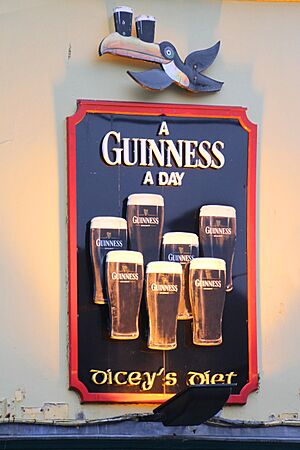
In 2000, Guinness's "Surfer" ad was named the best TV commercial ever in a UK poll. This ad showed a surfer riding a big wave.
Guinness won the "Advertiser of the Year" award in 2001. In 2003, a Guinness TV ad about explorer Tom Crean won an award. Their Irish Christmas ad, which shows snow falling in Ireland, also won an award.
The UK commercial "noitulovE" (Evolution spelled backward) was very popular in 2006. In 2006, Diageo changed the Michael Power campaign to "Guinness Greatness." This campaign focused on the "drop of greatness" in everyone.
Guinness's 2007 ad, "Tipping Point," showed a huge domino chain reaction. It was a very expensive ad to make.
In 2009, the "To Arthur" ad showed people around the world toasting Arthur Guinness. This led to an event called Arthur's Day. It is a celebration of Arthur Guinness and his beer.
After pubs closed during the COVID-19 pandemic, Guinness made an ad called "Looks Like Guinness." It was for when pubs reopened in 2021.
Guinness Around the World
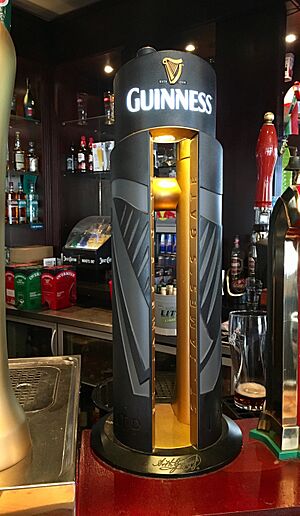
In 2006, sales of Guinness in Ireland and the UK went down a bit. But Guinness still makes up more than a quarter of all beer sold in Ireland. By 2023, Guinness became the most popular draught beer in the United Kingdom.
Guinness started selling in India in 2007.
Guinness is very popular in Africa. About 40% of all Guinness sold worldwide is made and sold there. Three of the five Guinness-owned breweries are in Africa.
The beer is also made under special agreements in many countries. These include Nigeria, Canada, Kenya, and Indonesia.
In 2017, Guinness worked with another company to sell Guinness in mainland China. China is a very big market for alcohol.
The United Kingdom drinks more Guinness than Ireland. Nigeria is the third-largest Guinness drinking nation, followed by the USA.
Guinness Attractions
The Guinness Storehouse at St. James's Gate Brewery in Dublin is Ireland's most popular tourist spot. In 2019, over 1.7 million people visited it. You can take a tour to learn how Guinness is made. You can also smell the ingredients in the Tasting Rooms.
The Guinness Book of Records actually started as a marketing gift from Guinness! The idea came from Sir Hugh Beaver, who was a director at Guinness. Guinness owned the company that made the record book until 2001.
Images for kids








